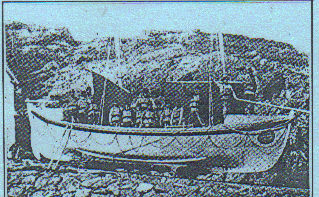GEORGE MOORE II LIFEBOAT
The following is an account of the second George Moore Lifeboat. For information about the First George Moore Lifeboat click here.
In June 1887, concern was expressed about the self-righting capabilities of The GEORGE MOORE and the R.N.L.I. decided to station a larger lifeboat at Porthdinllaen. To accommodate her, a new boathouse was built, together with a launch-slipway, the new house and slip costing a total of £1,414-12s-0d. The new lifeboat was a 39ft. x 9ft. 12 oared self-righter, built by Hansen, of Cowes, at a cost of £410. She arrived at Holyhead by rail on October 8th 1888 and was then sailed south to her station, this boat being appropriated to the "George Moore Lifeboat Fund" and was also named GEORGE MOORE.

The second 'GEORGE MOORE' 1888-1902 saving 22 lives on 11 service launches. Photograph from the files of the Late Grahame Farr.
The first service performed by the new lifeboat took place on November 2nd 1888, when she was launched at 3.45 p.m. to the schooner Emperor, of Beaumaris, which had parted one of her anchor-cables while sheltering in the bay, in heavy seas and a north-easterly gale, the lifeboat bringing the crew of three ashore.
At the beginning of January 1889, the Rev. Owen Lloyd Williams retired after serving as Station Honorary Secretary at Porthdinllaen for 19 years and a life-time's connection with the lifeboat service, the R.N.L.I. making him a special grant, in recognition of his years of devoted service. Mr J Evan Hughes, MRCS, took over as Honorary Secretary, being succeeded in that post in 1890 by Capt. Hugh Roberts.
When the schooner Rose, of Caernarvon, dragged her anchors and ran aground, in rough seas, an ENE gale and heavy snow, in the early hours of January 11th 1892, the GEORGE MOORE was launched at at 2.30 a.m. and rescued the crew of three. Later that year on May 3rd, the lifeboat was launched at 10 a.m. and rescued the crew of two from the smack Brothers, of Caernarvon, which was also dragging her anchors in the bay, in rough seas and a north-easterly gale. Following this service, the Coxswain Hugh Davies was taken ill, being off work for several months, the R.N.L.I. making him a special grant, by way of compensation.
In February 1893, a local boat-builder built a special 15ft. boarding boat for the Porthdinllaen Station, at a cost of £10, to enable some of the crew to come ashore when the lifeboat returned to her station and then help to re-house her, this boat being kept in a lean-to shed at the side of the look-out, which had just been built at the station.
Coxswain Hugh Davies retired in January 1894, being succeeded in that post by John Jones.
December 22nd 1894 was a particularly stormy day, with lifeboats from many stations being called out, no less than 99 lives being saved by 19 different lifeboats during that day. The GEORGE MOORE was launched at 1.00 p.m. into extremely heavy seas and a storm-force north-westerly gale, to go to the assistance of the smack Dauntless, of Jersey, which had been sighted drifting helplessly, having lost all her sails and spars in the storm. But, with the help of the lifeboat men, the boat, which had a crew of three, was brought to a safe anchorage in Porthdinllaen Bay.
Nearly twelve months later, on December 6th 1895, another north-westerly gale struck the Welsh coast and the schooner Gauntless, of Barrow, was dismasted 1 mile off Llanaelhaiarn. The GEORGE MOORE was launched at 10 a.m. and, with heavy seas breaking clean over the schooner, succeeded in rescuing the crew of 5, the lifeboat landing them at Trevor.
In very heavy seas and a NNW gale on September 25th 1896, the smack Venture, of Caernarvon, broke adrift in the bay and was driven ashore at Porthdinllaen. Coxswain John Jones and five other men, using ropes from the shore, were able to rescue the smack's crew of two. Nearly two weeks later, on October 8th, Coxswain Jones and four men, again using ropes, rescued the crew of three from the flat Caldwell, of Liverpool, which was driven ashore when she parted her anchor-cables in heavy seas and a WSW gale. The men were also able to bring ashore one man from the smack Messenger.
The GEORGE MOORE was launched at 9.00 a.m. on June 16th 1897, after the schooner Miss Hughes, of Caernarvon, with a crew of 4, bound for London with a cargo of slate, began to drag her anchors in rough seas and a north-westerly gale, the lifeboat putting two of her own crew on board, who helped to take the vessel to a safer anchorage in the bay.
What proved to be the last service by the GEORGE MOORE took place on December 28th 1900, when she was launched at 10.15 a.m., into extremely violent seas and a hurricane-force north-westerly storm, to go to the aid of the flat Caliban, of Liverpool. Coxswain Jones dropped anchor and the lifeboat was veered down towards the casualty, as huge waves swept over both boats, but eventually the flat's crew of two were rescued. The lifeboat men then found that their anchor had fouled something on the sea-bed and could not be recovered, so the line was cut and, under storm sail, they returned to Porthdinllaen, the lifeboat being run straight up onto the beach.
The above information was taken from 'The History of the Porthdinllaen Lifeboats' written and produced by Jeff Morris. I should like to thank Tom Morris, former crew member at Porthdinllaen, for giving me a copy of this book and giving permission for me to print these extracts. Also, thanks to Stephen Hoyle, webmaster of the Porthdinllaen Lifeboat website, for mailing the booklet to me.